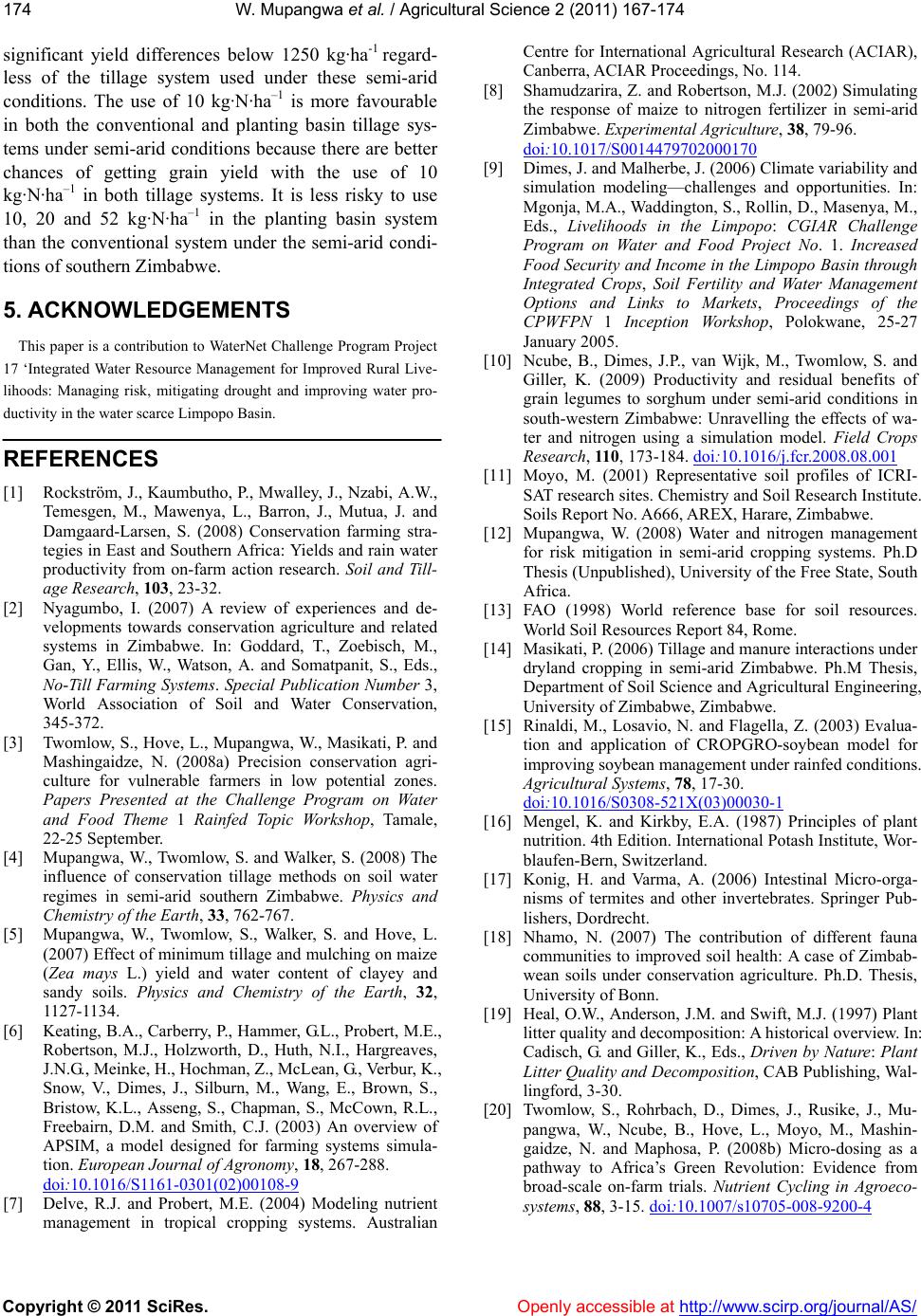
W. Mupangwa et al. / Agricultural Science 2 (2011) 167-174
Copyright © 2011 SciRes. Openly accessi ble at http://www.scirp.org/journal/AS/
174
significant yield differences below 1250 kg·ha-1 regard-
less of the tillage system used under these semi-arid
conditions. The use of 10 kg·N·ha–1 is more favourable
in both the conventional and planting basin tillage sys-
tems under semi-arid conditions because there are better
chances of getting grain yield with the use of 10
kg·N·ha–1 in both tillage systems. It is less risky to use
10, 20 and 52 kg·N·ha–1 in the planting basin system
than the conventional system under the semi-arid condi-
tions of southern Zimbabwe.
5. ACKNOWLEDGEMENTS
This paper is a contribution to WaterNet Challenge Program Project
17 ‘Integrated Water Resource Management for Improved Rural Live-
lihoods: Managing risk, mitigating drought and improving water pro-
ductivity in the water scarce Limpopo Basin.
REFERENCES
[1] Rockström, J., Kaumbutho, P., Mwalley, J., Nzabi, A.W.,
Temesgen, M., Mawenya, L., Barron, J., Mutua, J. and
Damgaard-Larsen, S. (2008) Conservation farming stra-
tegies in East and Southern Africa: Yields and rain water
productivity from on-farm action research. Soil and Till-
age Research, 103, 23-32.
[2] Nyagumbo, I. (2007) A review of experiences and de-
velopments towards conservation agriculture and related
systems in Zimbabwe. In: Goddard, T., Zoebisch, M.,
Gan, Y., Ellis, W., Watson, A. and Somatpanit, S., Eds.,
No-Till Farming Systems. Special Publication Number 3,
World Association of Soil and Water Conservation,
345-372.
[3] Twomlow, S., Hove, L., Mupangwa, W., Masikati, P. and
Mashingaidze, N. (2008a) Precision conservation agri-
culture for vulnerable farmers in low potential zones.
Papers Presented at the Challenge Program on Water
and Food Theme 1 Rainfed Topic Workshop, Tamale,
22-25 September.
[4] Mupangwa, W., Twomlow, S. and Walker, S. (2008) The
influence of conservation tillage methods on soil water
regimes in semi-arid southern Zimbabwe. Physics and
Chemistry of the Earth, 33, 762-767.
[5] Mupangwa, W., Twomlow, S., Walker, S. and Hove, L.
(2007) Effect of minimum tillage and mulching on maize
(Zea mays L.) yield and water content of clayey and
sandy soils. Physics and Chemistry of the Earth, 32,
1127-1134.
[6] Keating, B.A., Carberry, P., Hammer, G.L., Probert, M.E.,
Robertson, M.J., Holzworth, D., Huth, N.I., Hargreaves,
J.N.G., Meinke, H., Hochman, Z., McLean, G., Verbur, K.,
Snow, V., Dimes, J., Silburn, M., Wang, E., Brown, S.,
Bristow, K.L., Asseng, S., Chapman, S., McCown, R.L.,
Freebairn, D.M. and Smith, C.J. (2003) An overview of
APSIM, a model designed for farming systems simula-
tion. European Journal of Agronomy, 18, 267-288.
doi:10.1016/S1161-0301(02)00108-9
[7] Delve, R.J. and Probert, M.E. (2004) Modeling nutrient
management in tropical cropping systems. Australian
Centre for International Agricultural Research (ACIAR),
Canberra, ACIAR Proceedings, No. 114.
[8] Shamudzarira, Z. and Robertson, M.J. (2002) Simulating
the response of maize to nitrogen fertilizer in semi-arid
Zimbabwe. Experimental Agriculture, 38, 79-96.
doi:10.1017/S0014479702000170
[9] Dimes, J. and Malherbe, J. (2006) Climate variability and
simulation modeling—challenges and opportunities. In:
Mgonja, M.A., Waddington, S., Rollin, D., Masenya, M.,
Eds., Livelihoods in the Limpopo: CGIAR Challenge
Program on Water and Food Project No. 1. Increased
Food Security and Income in the Limpopo Basin through
Integrated Crops, Soil Fertility and Water Management
Options and Links to Markets, Proceedings of the
CPWFPN 1 Inception Workshop, Polokwane, 25-27
January 2005.
[10] Ncube, B., Dimes, J.P., van Wijk, M., Twomlow, S. and
Giller, K. (2009) Productivity and residual benefits of
grain legumes to sorghum under semi-arid conditions in
south-western Zimbabwe: Unravelling the effects of wa-
ter and nitrogen using a simulation model. Field Crops
Research, 11 0, 173-184. doi:10.1016/j.fcr.2008.08.001
[11] Moyo, M. (2001) Representative soil profiles of ICRI-
SAT research sites. Chemistry and Soil Research Institute.
Soils Report No. A666, AREX, Harare, Zimbabwe.
[12] Mupangwa, W. (2008) Water and nitrogen management
for risk mitigation in semi-arid cropping systems. Ph.D
Thesis (Unpublished), University of the Free State, South
Africa.
[13] FAO (1998) World reference base for soil resources.
World Soil Resources Report 84, Rome.
[14] Masikati, P. (2006) Tillage and manure interactions under
dryland cropping in semi-arid Zimbabwe. Ph.M Thesis,
Department of Soil Science and Agricultural Engineering,
University of Zimbabwe, Zimbabwe.
[15] Rinaldi, M., Losavio, N. and Flagella, Z. (2003) Evalua-
tion and application of CROPGRO-soybean model for
improving soybean management under rainfed conditions.
Agricultural Systems, 78, 17-30.
doi:10.1016/S0308-521X(03)00030-1
[16] Mengel, K. and Kirkby, E.A. (1987) Principles of plant
nutrition. 4th Edition. International Potash Institute, Wor-
blaufen-Bern, Switzerland.
[17] Konig, H. and Varma, A. (2006) Intestinal Micro-orga-
nisms of termites and other invertebrates. Springer Pub-
lishers, Dordrecht.
[18] Nhamo, N. (2007) The contribution of different fauna
communities to improved soil health: A case of Zimbab-
wean soils under conservation agriculture. Ph.D. Thesis,
University of Bonn.
[19] Heal, O.W., Anderson, J.M. and Swift, M.J. (1997) Plant
litter quality and decomposition: A historical overview. In:
Cadisch, G. and Giller, K., Eds., Driven by Nature: Plant
Litter Quality and Decomposition, CAB Publishing, Wal-
lingford, 3-30.
[20] Twomlow, S., Rohrbach, D., Dimes, J., Rusike, J., Mu-
pangwa, W., Ncube, B., Hove, L., Moyo, M., Mashin-
gaidze, N. and Maphosa, P. (2008b) Micro-dosing as a
pathway to Africa’s Green Revolution: Evidence from
broad-scale on-farm trials. Nutrient Cycling in Agroeco-
systems, 88, 3-15. doi:10.1007/s10705-008-9200-4